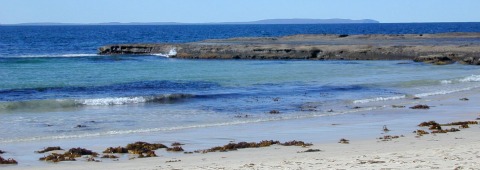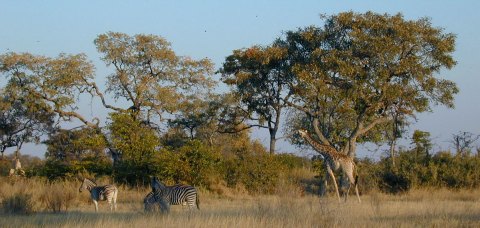Home | About CCW | Contact Us | Climate change Meaning | Causes | Solutions | Emissions | Carbon trading
Abrupt climate change
Abrupt climate change is a challenge for humans as a species. It is about the only thing that might push our unrivalled adaptability beyond its limit.
Climate change itself is not really the problem because we can absorb slow, gradual change just as natural systems do — even our more fickle economic systems could bend enough to cope with slow change.
It’s the fast change, the drastic and abrupt that will cause us problems.
Mostly we hear that there are many effects of climate change from
…the list is long.
These are the things that will impact upon us because they will cost money, disrupt our economies and increase our personal risk.
Doomsayers claim that these effects will cripple our food production, dry up water supplies and damage the natural environments beyond repair. And all this is much more likely to happen if change is quick.
So we hear a lot about abrupt climate change but how true are the claims of disaster?
The answer will take a little explaining.
Abrupt climate change at the beach
Imagine that you own a house on this beach.
It is a lovely spot on the south coast of NSW in Australia that is popular for holidays and those with the desire to kick back at the beach permanently. Your house is right in front of the water, you can skim stones from your front lawn.
But... should sea levels rise, then the risk of water in your lounge is real.
Just now there are storms and king tides that send waves close to the low garden wall. It is scary when this happens on a dark winters night but it always passes without major incident.
Then, as a result of rapid global warming the sea level rises by 50cm, half a meter.
What would happen?
Not much really, the high tide mark gets a little closer but the garden gate is still on higher ground, a full 1.5m higher. There is still a long way to go.
Then it comes, that windy night with a deep low pressure storm just offshore. Around midnight violent waves break the wall. Frothy surf rushes at your front door and salty water spills ankle deep across the carpet. There was no time to do anything. You were caught by surprise and the damage was done.
Reluctantly the insurance company pays out to have the place cleaned up and the carpets replaced, and then promptly raises your monthly premium.
Consequences of disturbance
Flooding of the land by seawater is about as abrupt climate change as it gets – dry to salty wet in an instant.
Few plants can survive inundation that closes off air supply to roots and salty water is worse as it changes the osmotic pressure in the soil water even after the flood subsides. This causes the plants cells to leak their vital fluids.
Animals big enough to move can escape to higher ground but not the billions of protozoa, mites, springtails and earthworms that help drive the nutrients around the soil system — many of these important soil organisms die.
It can take years, even decades for the front lawn to recover on its own. The same applies to all natural systems faced with a similar drastic disturbance.
The ecological interplay between organisms and their conditions is precise, shaped by untold generations of subtle adaptation where the process of natural selection favours organisms with the just the right mix of physiology, behaviour and form for the prevailing conditions. Change those conditions and many organisms become stressed.
Some species have the tools to cope with only a very narrow range of conditions. Other species have wider tolerance and it is a wonder of nature how this happens. It is also amazing how species mesh together to form alliances, symbioses, synergies and competitive plays that helps to stick the system together.
Now let’s say that we slowly warm things up for a forest or woodland ecosystem away from the coast.
Warming makes the night-time temperatures rise above average and reduces the number and intensity of frosts to a rarity.
This is fine really. Species that were kept out of the species mix because they were sensitive to frost may have a chance now and those that relied on frosty nights to cure their seed husks might have some trouble reproducing. We might see a few differences here and there but no catastrophic change. Most plants still grow well and the animals that feed off them continue as normal.
Keep the warming going so that daytime temperatures start to rise too, the soil dries out steadily and there is a drying wind on more days than it is still.
Many of the tree saplings desiccate and the broad-leaved plants suffer too. Some of the canopy trees die exposing the soil to sunlight and accelerate the drying. When it rains there are fewer plants to intercept the droplets and so more of the rain crashes onto the soil surface, bounces and spills away, unable to seep through.
In time spiny grasses begin to do well as they can sit out the dry, hot conditions better than the trees and shrubs. Animals that graze on these grasses also do well.
Before too long our woodland has become a savanna.
Unless you were around for a few thousand years you would not be able to watch this happen for this transition is slow – more succession than disturbance.
Yet all is well really. The species change but plants grow, animals feed and nutrients cycle.
What has happened is that species in the original mix have either
- tolerated the new conditions
- moved elsewhere or
- died out
And the new species that arrive must have either been close by or had the capacity to migrate from dry habitats elsewhere.
Coping with abrupt change
Species can tolerate change through behaviours, a flexible physiology and life-cycle (the technical term for this is phenotypic plasticity) or by adaptation across generations.
Behavioural adjustment can be immediate; physiological tolerance can allow an organism to cope for a week or two, maybe a few months; and adaptation can be a long-term solution. The problem with adaptation is it requires enough generations to allow for evolution.
Now suppose that we warm things up fast so that we have abrupt climate change.
It is now much harder for species to tough it out, dry conditions come quickly and there is not enough time for species to evolve through generations. Short–term solutions through behaviour and physiology work but it’s harder. Many individuals perish.
Plants die before new species have a chance to arrive.
Bare ground begins to appear and when the rain comes it erodes away the drying soil.
Conditions for new arrivals are harsh and they have difficulty establishing.
Normal functioning declines, with less plant growth, fewer animals and a general slowing down of nature.
Nature does not mind, of course, it treats such abrupt climate change as a disturbance, a shakeup to the system. A period with dry, dusty, bare soil is no matter, new species will establish in the end…
unless, of course, there are hungry human mouths to feed.
The conundrum
Climate change is natural and normal and when it’s slow ecosystems cope, they have a level of resilience that keeps them going often without any perceptible differences in production or function. Some species are lost, but others arrive or evolve to replace them.
Change is quite normal for nature.
Abrupt climate change is something else and it is the reason why the IPCC and some scientists talk of catastrophic change, for fast climate change risks disruption to natural and production systems beyond their capacity to cope.
Quick shifts to less rain or more frosts or many hot days stretches the resilience of the system and results in rapid changes to composition and function, even collapse.
If this happens abrupt climate change would be a catastrophe for us.
And here is the thing. For humans abrupt climate change has the potential to bring about reductions in plant growth that mean our food supply shrinks. And that is why we should be concerned about abrupt climate change.
We have already altered natural systems to our ends [we use over half the global primary production from plants] and made them less resilient to the kinds of climate change that they used to shrug off without a care.
Related pages on climate-change-wisdom...
Links to the science
If you would like to find out more, click on the authors below that link to some scientific papers on this topic...
Alley, R. B., Marotzke, J., Nordhaus, W. D., Overpeck, J. T., Peteet, D. M., Pielke, R. A., … Wallace, J. M. (2003). Abrupt climate change. Science (New York, N.Y.), 299(5615), 2005–2010.
Hulme, M. (2003). Abrupt climate change: can society cope? Philosophical Transactions. Series A, Mathematical, Physical, and Engineering Sciences, 361(1810), 2001–2019; discussion 2019–2021
Schneider, S. H. (2004). Abrupt non-linear climate change, irreversibility and surprise. Global Environmental Change 14(3) 245-258
Wunsch, C. (2006). Abrupt climate change: An alternative view. Quaternary Research, 65(2), 191–
The links go to the websites of the publishers of this material. In some cases it is possible to find out more by entering the title of the paper into Google Scholar.
climate change wisdom › meaning › abrupt climate change
Recent Articles
-
Reducing emissions while looking for solutions...
Nov 01, 15 04:46 PM
I've seen a lot of post's online for ideas on reducing emissions. The one suggestion I have not seen, is the most obvious. There should be a government -
Climate change evidence
Mar 24, 15 06:22 AM
Real climate change evidence has to demonstrate a change in climate. An extra sunny day or a severe storm or a flood is not enough. -
The climate change effect
Feb 19, 15 03:08 AM
What will be the climate change effect? There isn't one, there are many. Perhaps too many for us to understand.





New! Comments
Have your say about what you just read! Leave me a comment in the box below.